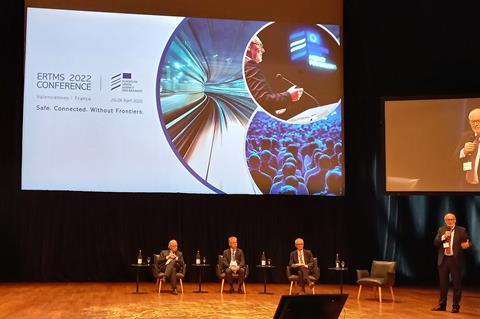
EUROPE: More than 500 delegates converged on Valenciennes for the 2022 ERTMS Conference organised by the European Union Agency for Railways, which focused on the technical advances, deployment strategies and the political imperatives that will shape the roll-out of the European Rail Traffic Management System over the coming years.
Although deployment has been patchy, ERTMS is now a reality in many countries. Pressure is growing for the roll-out to be accelerated, driven in part by the European Union’s Green Deal and the European Commission’s modal shift ambitions. Speakers from Italy, Spain, Germany and Denmark explained their deployment strategies, emphasising the need to reduce costs in order to improve interoperability and enhance the competitiveness of a more sustainable transport mode. Spain in particular was cited as a good example of ERTMS deployment, with ETCS now in use on most high speed lines and plans advancing for its installation on regional and commuter lines.
Antonella Trombetta, Director of European Affairs at Hitachi Rail, emphasised that over the past decades more ERTMS had been installed outside Europe than in it. Matthias Ruete, the European Commission’s ERTMS Co-ordinator, reminded delegates that EU funding was available to support deployment.
Insisting that ‘we are moving ahead on making ERTMS a reality’, Ruete emphasised that the revision of the TSI on Command Control & Signalling being adopted this year will require ERTMS to be deployed on the whole of the TEN-T core network by 2030 and on the comprehensive network by 2040. This would enable the decommissioning of the various Class B systems — the legacy national safety systems used in the different member states — and he urged that this should happen as soon as possible.
Some speakers argued that an intermediate option was needed between the legal requirement and tight deadlines being promoted by the European Commission and the national deployment policies which currently do not set a binding timescale. Many panellists felt that the national ERTMS programmes needed to be co-ordinated at a European level.
A major concern remains the cost and complexity of retrofitting of existing rolling stock, and the Community of European Railways again emphasised the importance of the need for stable specifications to ensure forward compatibility.
Although few major contracts have been signed for retrofitting large rolling stock fleets, Alstom presented details of its contract in Norway. This covers the fitting of onboard ETCS equipment to 650 vehicles of 60 different types as part of the national roll-out. After initial pilot testing, the first series installations are scheduled for October 2022, with all trains to be retrofitted by 2026.
Improving performance
Among the ‘game changer’ technologies included in the latest TSI revision package, most attention focused on the implementation of Automatic Train Operation in conjunction with ETCS Level 2. Most panellists anticipated that the more consistent operation achievable with ATO would help to increase network capacity, reduce energy consumption and improve service quality.
ATO over ETCS is already operational in London, and is now being trialled on a section of the Hamburg S-Bahn, whilst Deutsche Bahn has started work on a major roll-out in Stuttgart as part of the Digitale Schiene Deutschland programme. All of these use Grade of Automation 2, where there is still a driver in the cab, but plans are taking shape for a demonstration of unattended ATO to GoA4 in January 2023.
SNCF Réseau CEO Luc Lallemand pointed out that the benefits of ERTMS differed between countries, depending on the initial technical condition of each network. Having previously been CEO of Infrabel, he explained that the Belgian network had no safety system to prevent trains from passing a red signal. So it was easier to convince the authorities of the need to install ERTMS across the entire network, which has now largely been equipped. In France, by contrast, the legacy TVM and KVB train protection systems were already widely deployed, so the added value offered by ERTMS was more marginal. However, he emphasised that this did not signify that France did not want ERTMS; two major projects have been launched. One involves conversion of the Paris – Lyon high speed line from TVM and the other involves fitting ETCS on the Marseille – Ventimiglia conventional line. Both are being equipped with Level 2, with provision for an upgrade to ‘hybrid’ Level 3.
In a workshop on maximising performance, Peter Reinhart of DB Projects warned of the need to be careful when overlaying ETCS on a legacy Class B system. Citing the ERTMS deployment on the Stuttgart S-Bahn, he said DB had concluded that this would actually decrease capacity rather than increasing it, because of the modifications needed to allow the retention of PZB and LZB, which led to restrictive braking curves and other procedures.
Many panellists hoped that these interface issues could be addressed though the System Pillar of the Europe’s Rail research programme, which they felt was an essential step for improving ERTMS.
A major change for the future will be introduction of FRMCS as the next generation of radio communications, replacing GSM-R as the bearer for ETCS. This is essentially reliant on changes in telecoms hardware, requiring the introduction of 5G technology in each country.
Throughout the conference, speakers emphasised that ERTMS offered a way to accelerate the digitalisation of railway operations, and that accelerating its deployment would be a key to improving digitalisation of other processes.
Summing up the event, ERA Executive Director Josef Doppelbauer said it had provided a ‘window of opportunity’, which ‘focused on the lessons learnt, on the sector expectations, and on the way forward’.

















